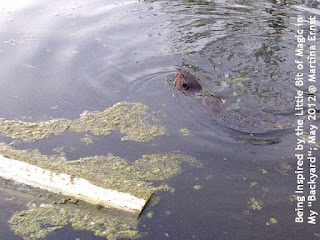Image: “Nervous Breakdown” by Lyod
Source: photobucket.com: Spaga_2009: media: DREAM: Nervous Breakdown
Source: photobucket.com: Spaga_2009: media: DREAM: Nervous Breakdown
Ecosystems Help Maintain Psychological Well-Being
Imagine you’ve had “one of those days.” It starts out slow and dull after a long night of tossing and turning (the neighbourhood cats decided to have a social outside your bedroom window). You pine for a cup of java, but find you’ve run out of instant coffee cups. After scraping the charred bits off of some burnt toast (someone left the setting on “scorched earth”), you hear the time on the radio…7:55.That’s when it hits you: you forgot you had an 8:30am meeting downtown today.
You LEAP into action (read: panic) mode: run through a frighteningly icy shower (the landlord is “still working on that”), throw on some kinda-sorta-ironed clothes and race for the car.
The traffic seems as if it was going backwards. Every light bleeds crimson. The clock in your car advances feverishly. You curse Einstein and his Law of Relativity (“time and space are not constant. Fine. But why do they always seem to work against me!?”).
You realize you’d better call your boss to let him her know you’re going to be late. That’s when you realize you left your phone in the den next to the fish tank.
Arriving late and somewhat dejected, you have no choice but to pick the flat-rate $40 parking garage in the luxury hotel, and still have to drive 5 levels down past row upon row of luxury sedans, sports cars and SUVs…their obnoxiously enormous headlamps and grills sneering at your pre-owned subcompact.
The remaining 30-minutes of the meeting go awkwardly. The potential client is stand-offish at best and hostile at worst. “But thanks for the late breakfast.”
Your boss is not impressed.
You collect your car; head to the office. There you are met by a mountain of emails needing your reply. Your thoughts turn to the “Missed Call” counter ticking up on your phone; messages hungrily gobbling up your limited voicemail box capacity. You wonder if fish can spontaneously develop telephone skills. Maybe they could have bike courier break into your place and bring you your phone?
What if that “special friend” you met recently is trying to call? What if your mother is trying to call? “Hmm...maybe leaving the phone at home was a blessing in disguise,” you muse to yourself.
Then it happens: your computer just stops. And no, re-booting the system will not get it to start.
Several hours of dealing with your own I.T. department (“Ned”), navigating automated phone systems, desperately trying to speak to—and be understood by—technical support somewhere in South Central/Eastern Asia, only to have to take your unit into a repair depot where after a 20-minute test it’s confirmed you’ll need a new hard drive. “Why couldn’t someone tell me that to begin with!?”
Don’t worry, eventually you do make it home: an empty apartment (except for some fish and a cell phone filled with missed calls and voicemails), an empty fridge, coupons for delivery pizza and/or Chinese food, hundreds of channels of trash on the TV, and countless webpages online to numb you to sleep (at least, you would have, if the Internet wasn’t on the fritz. Your landlord says “the ISP is supposed to be working on that.”)
Just then, deciding to clean out your voicemail box, you get the message from your “special friend.” They’ve met someone else and can’t see you anymore.
That’s the last straw: a seething rage erupts from inside! Your entire body seizes up with an intense eruption of energy, completely taking hold of you, and in a split second of explosive impulsiveness, you watch as your arm hurls your smartphone against the wall, smashing the glass on your favourite limited edition print, ripping the photo beneath.
Observe yourself right now, in this moment. We all know the feeling of having “one of those days.” The question is how do we handle such days?
Do we let each “little thing” get to us, however imperceptibly? What happens after the second, third, fourth…tenth “little thing?” Do we sweat the little things just enough that they add “another straw” to the camel’s back?
There really is no difference between a “little thing” and a “big thing.” Psychologically speaking, the small stuff and the big stuff are the same: something that didn’t go our way; an unexpected outcome which upset our expectations (it’s our expectations which cause the upset).
Often, we identify “big stuff” based on our reaction. However, in the above story, clearly the reaction was related to all the small stuff which occurred during the day. The straw that breaks the camel’s back takes the heat for everything, but it was just another in a series of incremental increases in negative energy.
So what does any of this have to do with PeapodLife and ecosystems?
Imagine if you had an ecosystem at home and at work. Imagine a lush, green indoor environment filled with fresh clean air—like being in a rainforest or outside in nature after a fresh summer rain. Reread the above story and after each paragraph add the following:
Then you look at the ecosystem: it’s lush moss, beautiful bromeliads, delicate orchids, at once vibrant and soothing. You take a long, deep breath of the pure, fresh, clean air. You close your eyes for just a moment and take in the delicate calming sound of trickling water. “Life is good,” you think to yourself.
Image by PeapodLife: Custom Living Wall Ecosystem brings soothing nature into an office space.
Now imagine children at school. Employees at work. Parents in the retirement home. Patients in the dental clinic. Clients in the spa. Imagine all those little barbs of negative energy being dissolved, moment by moment, instead of building up inside.
The power of nature to help us maintain balanced mental well-being is priceless. That’s the power of PeapodLife.













